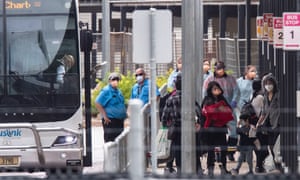Australia's
coronavirus
pandemic plan: mass
vaccinations and stadium
quarantine

27 February, 2020
Governments
may order mass vaccinations of entire suburbs, cities or groups of
people; sports stadia may be sequestered as quarantine sites; and
police could be ordered to guard critical medical supplies under
Australia’s pandemic health plans.
Under
worst-case scenarios being contemplated by state and federal
governments, forecasts say a pandemic outbreak could last up to 10
months, and 40% of the country’s workforce could be sidelined by
illness or caring for family members. Australia’s GDP could take a
10% hit.
The
pandemic plans have not yet been scaled up to their highest levels:
Australia remains in containment mode and governments have
consistently said that Australia is well-placed to deal with any
outbreaks.
Currently,
out of 81,000 confirmed Covid-19 cases worldwide, which have caused
more than 2,700 deaths, just 22 have been identified in Australia,
with zero deaths.
“Pandemic
influenza can cause significant disruptions to the way we live as it
has the potential to result in high levels of illness and death,”
the Victorian government has warned in its action plan for influenza
pandemic.
“The
social distancing measures that may be required will have
wide-ranging effects, with closure of schools and childcare services,
and cancellation of public events. It is estimated that up to 40% of
the workforce may withdraw from work at any one time due to illness,
the need to care for family members or the fear of contracting the
virus in the workplace or on public transport.
“One
study estimated that in a worst-case pandemic influenza scenario,
Australia’s gross domestic product could suffer a decline of
greater than 10%.”
State
and federal governments have had pandemic plans in place for years,
prepared for the possibility of a novel coronavirus or a wide-scale
influenza outbreak.
The
publicly available plans emphasise that predicting the length,
severity and impact of a coronavirus – such as SARS-CoV-2 –
outbreak is difficult, given a large number of unknown and variable
factors.
“The
impact of a pandemic depends on how sick the virus makes people
(clinical severity), the ability of the virus to spread between
people (transmissibility), the capacity of the health system, the
effectiveness of interventions and the vulnerability of the
population,” the New South Wales government’s human influenza
pandemic plan says.
“As
humans will have little or no pre-existing immunity to a pandemic
virus and influenza viruses can be transmitted among people without
symptoms, prevention is not considered realistic.”
But
the NSW Health plan makes a number of fundamental assumptions about a
pandemic outbreak in Australia:
The
disease is likely to originate overseas and be imported into
Australia by infected travellers.
“As
infected travellers may have no symptoms on their arrival into
Australia, border screening of incoming passengers is unlikely to be
of benefit in preventing a pandemic influenza strain entering the
country,” NSW Health says.
If
and as a pandemic worsens, contingencies could see the ordering of
schools closed and of public transport altered in order to implement
social distancing measures. Mass gathering events, such as sporting
events or concerts, may be cancelled.
People
may be advised – or even ordered – to work from home if possible.
People
will be forced off work if they are ill, to care for family members,
or by advice – or orders – to self-isolate.
Hospitals
may need to set up screening stations outside emergency departments
and designate specific “flu areas” within hospitals to ensure
coronavirus patients are isolated from others. If hospitals are
overrun, operating theatres or general wards could be requisitioned
as intensive care surge areas and children may be able to be treated
and managed at adult hospitals.
“Overflow
facilities are used to accommodate patients when it is impractical to
manage them at home or in a hospital,” NSW Health says. “Healthcare
facilities, including private hospitals, would be used
preferentially. However, schools, warehouses, convention centres,
hotels or sports arenas may be alternative sites.”
“I
think it’s much, much safer that way,” Sutton said. “We have to
proceed with planning on the basis it is inevitable and we can and
should expect more cases in Australia in the coming weeks or months.
I don’t want to see us get caught out at all.”
Sutton
said hospital contingency plans would adapt depending on the severity
of the outbreak.
“That
might look like cohorting where you have a respiratory ward for
coronavirus patients in hospitals,” he said. “It might have a
separate stream for emergency department patients.”
There
is currently no vaccine for Sars-CoV-2 – the novel coronavirus that
causes Covid-19 – but work is under way to develop one.
When
an effective vaccine is developed, the NSW Health pandemic plan
outlines two potential scenarios: “vaccination of priority with a
candidate or pandemic-specific vaccine, or mass vaccination for the
wider local health district population with a pandemic-specific
vaccine”.
In
the event of a severe pandemic outbreak, police forces may be drafted
in to protect key medical supplies, with responsibility to “plan
and implement security of the national medical stockpile and state
medical stockpile … of anti-influenza medicine and personal
protective equipment”.
Social
distancing strategies, voluntary at first but enforced if necessary,
could be implemented across the country. That might include
quarantine in designated secure sites (such as the Manigurr-ma
village in the Northern Territory); home isolation; exclusion, where
people are asked to exclude themselves from childcare, school,
educational facilities, workplace



No comments:
Post a Comment
Note: only a member of this blog may post a comment.